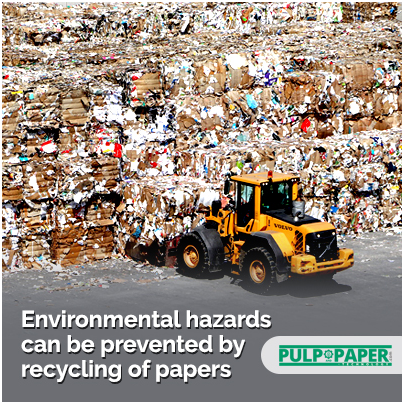Articles
Striking balance in environment through paper industry

The pulping process in a paper making industry is a source to three major pollution in the environment. These include air pollution, water pollution and deforestation. Recent reports on global paper industry stated that, the use of paper has increased by four fold times, in the last 50 years. In the year 2014, when the global production of paper industry had hit 400 million tonnes for the first time, with this the atmospheric carbondioxide (CO2) levels had exceeded 400 parts per million, with the higest toxic levels.
In a paper industry, the pulping process is the most complex phenomena, as its processing requires sulphur compunds to break down the wood into pulp. Most of the times, during the pulping process in paper making, the sulphur compunds escape the process and are released into the atmosphere. Sulphur compounds such as hydrogen sulphide, dimethyl sulphide which is emitted during pulping process of paper have a pungent odour. These harmful emissions gets escaped into the atmosphere, as paper and pulp mills do not have odor control devices.
Pollutants from paper industries disturb the energy balance on earth
The pollutant dimethyl sulphide carries the potential to affect the climate, apart from environmental hazards. Not only this, it also increases the aerosol loading in the atmosphere, either through nucleation or condensation on other areosols , which effects the energy balance on earth. One can make this out, by the way the sunlight is being refelected directly on the earth, or it is being reflected via aerosols or modifying clouds. In such cases, the sunlight which is a pure source of vitamin D, likely to get contaminated.
Nitrogen dioxide(NO) sulfur dioxide (SO) and carbon dioxide (CO) are produced from paper making industries. All the pollutants emitted during paper manufacture causes acid rain and CO is a major greenhouse gas that causes climate change. These toxic gases contribute to air pollution. Waste water may also be polluted with organochlorine compounds.
These pollutants emitted from pulping process in paper making industries are highly inflamable and causes health hazards like irritation in eyes, infections on skin. Not only this, the latest United Nations report show that, in the last ten years have greenhouse gas emissions have increased. Climate ambition needs to rise at least fivefold to meet the 1.5°C target of the Paris Agreement. And the world may be currently be heading for a temperature rise of over 3°C.
International Environment Laws and its regulating bodies
Environmental hazards caused due to the above mentioned factors, is a clear violation of the clauses of two major declaration of International Environment Laws (IEL). This includes Declaration of the United Nations Conference on the Human Environment (the 1972 Stockholm Declaration) (UN Doc. A/CONF/48/14/REV.1 (1972), and The Rio Declaration on Environment and Development. The Declaration of the United Nations Conference on the Human Environment deals with the global human impact on the environment, and aims at preserving and enhancing the human environment. And as far as Rio Declaration on Environment and Development, it was produced at the 1992 United Nations Conference on Environment and Development (UNCED), known as the Rio Earth Summit. The Rio Declaration consists of 27 principles intended to guide future sustainable development around the world.
The United Nations Environment Programme (UNEP) established by the United Nations General Assembly in 1972 plays an active role in promoting the principles of these declarations to prevent environmental hazards. It acts as a watch dog, on the implementation of the clauses through programmes like Earth watch, information exchange, monitoring environmental issues, and a continual review and evaluation of the environment on global scale to identify new problems.
As if now, there are six major International Organizations fighting environment hazards and destruction, they are
1. Earth System Governance Project (ESGP)
2. Global Environment Facility (GEF)
3. Intergovernmental Panel on Climate Change (IPCC)
4. International Union for Conservation of Nature (IUCN)
5. United Nations Environment Programme (UNEP)
6. World Nature Organization (WNO)
Punishments for violating Environmental Laws
The international entities and resolution, apart from formulating policies on environmental concerns, also aims at making its 193 member states to formulate laws, which would define the punishment, for the violation of the clauses of the declarations. As a result of this several national environmental protection agencies have been formed, to implement the international and national policies related to environment. This is done for effective promulgation and enforcement of laws.
For example in countries like USA, the Environmental Protection Agency (EPA) is pivot for the implementation of the environmental policies in the country. EPA works to ensure compliance with environmental requirements. When warranted, EPA will take civil or criminal enforcement action against violators of environmental laws.
In the same way, in India, environmental concerns and the international environmental laws has made the government come up with several acts, for the protection of the environment. Some of them include
1. The Air (Prevention and Control of Pollution) Act, 1981
2. The Water (Prevention and Control of Pollution) Act, 1974
3. The Environment Protection Act, 1986
4. Public Liability Insurance Act, 1991
To ensure proper compliance of these acts and its policies, the government has decalred that, it was necessary for industrial entities to follow the same. These acts and policies of the government also defines the punishment for its non compliance, starting from Rs 1,00,000 in the form of penalty to five years of imprisonment and sometimes even both. All the violations under the environmental protection acts are charged under criminal sections as Constitution under Part IVA (Art 51A-Fundamental Duties) casts a duty on every citizen of India to protect and improve the natural environment including forests, lakes, rivers and wildlife, and to have compassion for living creatures. Further, the Constitution of India under Part IV (Art 48A-Directive Principles of State Policies) stipulates that the State shall endeavour to protect and improve the environment and to safeguard the forests and wildlife of the country.
Remedial measures to avoid legal and environment conflicts in paper industries
Paper industry is one of the largest units which generates 3.5 million employment to the people. There are several ways, by which pulping process of paper in units across the globe can be made an environmental friendly phenomena, by embarking on sustainable mode of development. Some of these modes includes installing of eco friendly systems within the industrial units and by reducing the process modifications and improving the operating conditions.
For example in the second instance, black liquor oxidation systems, which oxidizes sulphites into less reactive thiosulphates, will reduce odorous sulphur emissions from the direct contact evaporator. The non condensable pungent gases which is produced from the digester/blow tank system and multiple effect evaporators, can be destroyed through thermal oxidation, by making it pass through lime kiln.
Proper supervision, during the operation of recovery furnace, to ensure that it not overloaded, and sufficient oxygen, residence time and turbulence is maintained, will reduce the toxicity of sulphur compounds which escape in the atmosphere. The Environmental Protection Agency (EPA) (1995b) reports also suggests that, the use of fresh water instead of contaminated , condensates in the scrubbers and the pulp washers further reduces the odorous emissions.
The next important way is by installing recovery systems within the paper mills which, eliminates conventional direct contact evaporators. According to recent study of Environmental Protection Agency (EPA) (1995b) of USA, the two systems from which hazardous emissions are produced. The first being the system, in which, heated combustion air, rather than fuel gas, provides direct contact evaporation. In the other system, where multiple effect evaporator system is extended to replace direct contact evaporator altogether. In both the systems, sulphur evaporators can be reduced by 99 percent.
The pulping process in paper making industries can certainly become one of the most cost effective eco friendly phenomena, if we strive to implement the international and national policies. This should not be seen as a force, but as a moral duty to make it happen, for a polluted free environment is key constituent of longevity and sustainable development.




